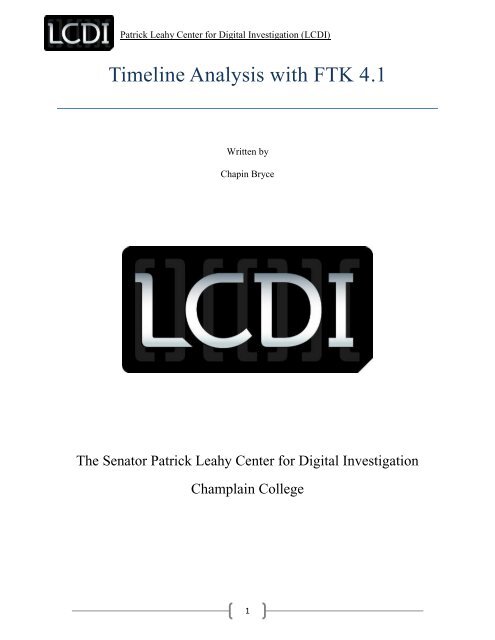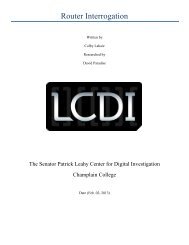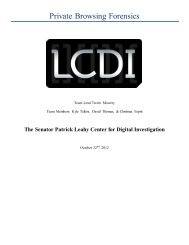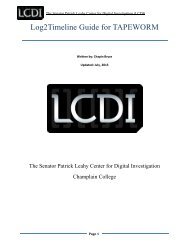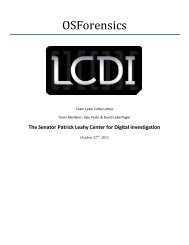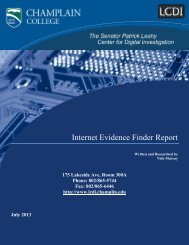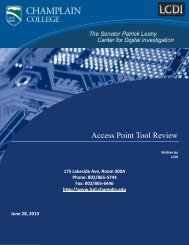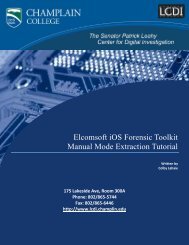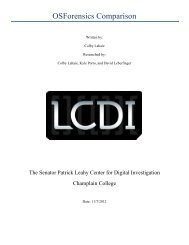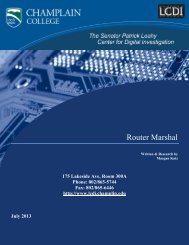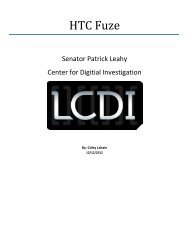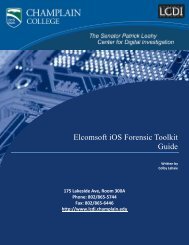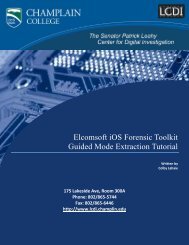Timeline Analysis with FTK 4.1 - Computer and Digital Forensics
Timeline Analysis with FTK 4.1 - Computer and Digital Forensics
Timeline Analysis with FTK 4.1 - Computer and Digital Forensics
You also want an ePaper? Increase the reach of your titles
YUMPU automatically turns print PDFs into web optimized ePapers that Google loves.
Patrick Leahy Center for <strong>Digital</strong> Investigation (LCDI)<strong>Timeline</strong> <strong>Analysis</strong> <strong>with</strong> <strong>FTK</strong> <strong>4.1</strong>Written byChapin BryceThe Senator Patrick Leahy Center for <strong>Digital</strong> InvestigationChamplain College1
Patrick Leahy Center for <strong>Digital</strong> Investigation (LCDI)Table of Contents<strong>Timeline</strong> <strong>Analysis</strong> <strong>with</strong> Forensic Tool Kit 4 .................................................................................................... 32
Patrick Leahy Center for <strong>Digital</strong> Investigation (LCDI)<strong>Timeline</strong> <strong>Analysis</strong> <strong>with</strong> Forensic Tool Kit 4AccessData’s Forensic Tool Kit (<strong>FTK</strong>) is a case analysis tool. To use <strong>FTK</strong> for timeline analysis, thepreprocessing options (displayed when adding evidence to the case) must be used. Unlike EnCase, <strong>FTK</strong>does not have a built-in feature to display timeline information. To create a timeline report for viewing,a case must first be created [See Figure 1].Figure 1Once the new case is opened, evidence must be added to the case [See Figure 2]. <strong>FTK</strong> is built to h<strong>and</strong>lemultiple partitions <strong>and</strong> file system types, including HFS+, EXT4, NTFS, <strong>and</strong> FAT partitions, all found in theFIRE image used for this guide.Figure 23
Patrick Leahy Center for <strong>Digital</strong> Investigation (LCDI)Once evidence is added to the case, selecting the refinement options allows the desired processingoptions to run. To create a timeline in <strong>FTK</strong>, remember to select the HTML <strong>and</strong>/or CSV file listing optionsfrom the evidence processing window [See Figure 3]. These options tell <strong>FTK</strong> to create a list of files inHTML/CSV format, including the path, file name, MAC timestamps, <strong>and</strong> MD5, among others. This is theonly feature allowing for timeline analysis of the drive, so be extra diligent in selecting them whileprocessing the case.Figure 34
Patrick Leahy Center for <strong>Digital</strong> Investigation (LCDI)Figure 4Running the preprocessing <strong>with</strong> this many options selected can be time consuming <strong>and</strong> can also cause<strong>FTK</strong> to consume a large number of computer resources while it runs. Once the task is complete, navigateto the job folder or select the job folder button on the data processing window [See Figure 4]. Withinthe case directory are the HTML/CSV file listings generated by <strong>FTK</strong> [See Figure 5].Figure 55
Patrick Leahy Center for <strong>Digital</strong> Investigation (LCDI)The CSV report can be opened <strong>with</strong> Microsoft Excel <strong>and</strong> formatted as desired [See Figure 6].Figure 6The HTML document can be opened <strong>with</strong> any web browser [See Figure 7].Figure 7It is important to note that both report types contain file names & attributes, such as MD5 <strong>and</strong> logicalsizes, along <strong>with</strong> created/modified/accessed dates for each entry found <strong>with</strong>in the <strong>FTK</strong> <strong>4.1</strong> case for theevidence.6


